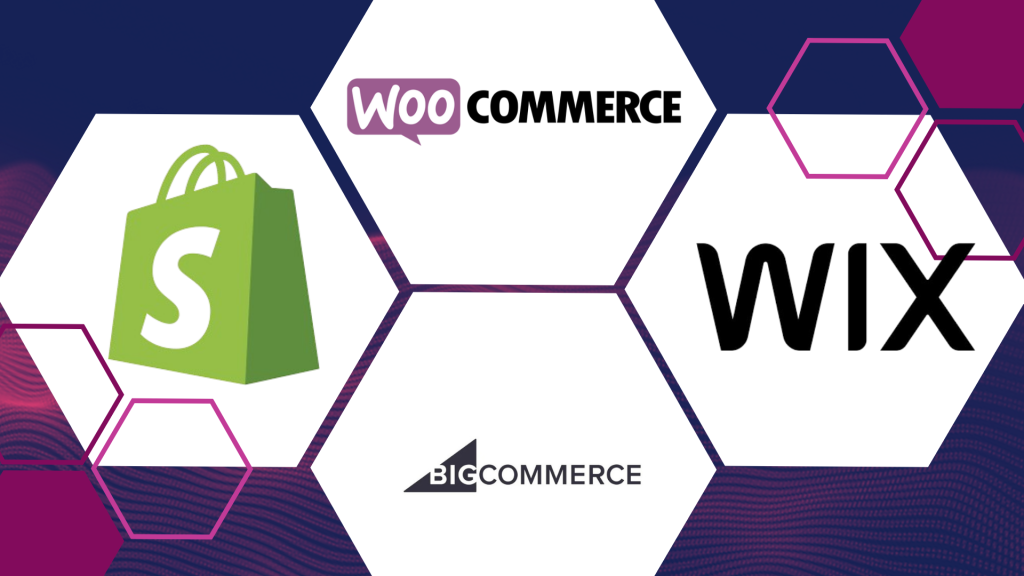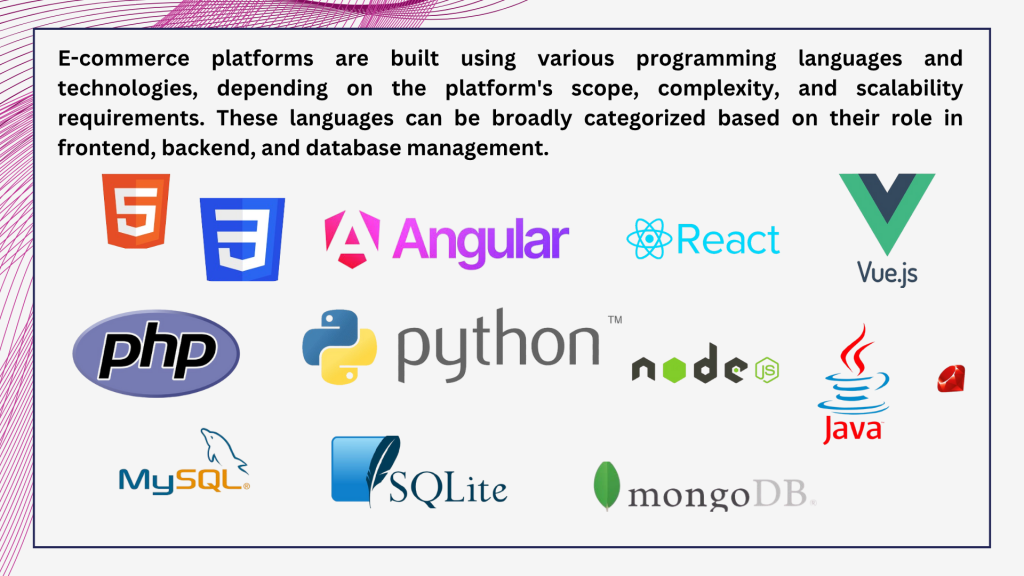E-Commerce Website

E-commerce or electronic commerce, is trading goods or services over the internet and transferring money and data to make the transactions possible.
E-commerce website is a specific platform or website designed to facilitate e-commerce.It’s an online platform for customers to look at products, pay for them, add them to their cart and follow their orders.
- Introduction
- Types of eCommerce Models
- Key Features of e-commerce platform
- Which languages, tools, and platforms are used to develop an e-commerce website?
- Advantages of e-commerce
- Disadvantages of E-Commerce
- E-commerce development face challenges
- Conclusions
1. Introduction
It is an online platform where businesses handle buying and selling online. Features commonly seen include catalogs of products, options for sorting products, a place to add items to a shopping cart, safe ways to pay, and tools for handling orders. They allow organizations to sell across the globe, always be available to users at any time, and open ways to new groups of customers.
2. Types of eCommerce Models
- B2C (Business to Consumer):The standard business model consists of companies providing products to direct end consumers. (e.g., Amazon, Walmart).
- B2B (Business to Business): Organizations market their products and services to businesses throughout the marketplace.(e.g., Alibaba).
- C2C (Consumer to Consumer): Organizations engage in product and service marketing activities across business sectors of the marketplace.(e.g., eBay, Craigslist).
- C2B (Consumer to Business): People market goods and services to corporate entities. (e.g., freelancers offering their services to companies).
3. Key Features of e-commerce platform
- Product Listings: Businesses show available items for purchase through displays which combine pictures with detailed information such as prices and product specifications.
- Shopping Cart: A virtual cart where customers can add items they wish to purchase before proceeding to checkout.
- Payment Gateway: Payment processing software enables users to make secure transactions through credit/debit cards and online wallet services (such as PayPal) and alternate payment methods.
- Checkout Process: The checkout process requires customers to examine their order details while entering shipping information and making payment.
- User Accounts: Customers can build profiles which enable profile management for storing personal information as well as order tracking and preference customization.
- Search & Filters:A search function combines with filters allowing customers to quickly identify particular products by category and price range and more evaluation criteria.
- Product Reviews: Through customer reviews and product ratings shoppers receive essential information to support their purchasing decisions.
- Security Features: The protection of customer information relies on SSL certificates with secure online transactions alongside data encryption and fraud protection measures.
- Inventory Management: This system monitors product inventory levels while alerting company owners about restocking requirements.
4. How are programming languages, tools and platforms used to make an e-commerce website?
The construction of an eCommerce website requires diverse programming languages alongside various tools and platforms to successfully build an operational secure online store which maintains growth potential. This document presents a breakdown of fundamental languages and tools alongside platforms used for eCommerce website construction.
Programming Languages are used to build the front-end (what the user sees) and back-end (server-side) of the website.
4.1.1. Front-End (Client-Side):
- HTML: Used for structuring the content of web pages.
- CSS: Used to style the layout, design, and appearance of the website (e.g., colors, fonts, margins).
- JavaScript: Used to create interactive and dynamic features, such as image sliders, forms, and pop-up modals.
- React.js or Angular: JavaScript frameworks/libraries that help in building fast and interactive user interfaces.
- Vue.js: Another JavaScript framework for building modern UIs and single-page applications.
4.1.2 Back-End (Server-Side):
- PHP: It is a widely used programming language for server-side development, including on WordPress (WooCommerce) and Magento.
- Node.js: A JavaScript runtime that allows you to build scalable, server-side applications.
- Python: It is often combined with frameworks such as Django and Flask for working on the server.
- Ruby: Used with Ruby on Rails for building eCommerce websites.
- Java: A robust language used for building large-scale enterprise-level applications.
- #C: Commonly used with the .NET framework for building enterprise-level eCommerce sites.
4.1.3. Databases
An eCommerce website requires a database to store product details, customer information, order history, and more.
- MySQL: A widely used open-source relational database management system.
- PostgreSQL: Another relational database that is known for its robustness and support for complex queries.
- MongoDB: A NoSQL database often used for large-scale applications.
- SQLite: A lightweight relational database, commonly used in smaller projects.
4.2. E-Commerce Platforms
Developers often rely on existing platforms to set up an eCommerce website, instead of designing everything from the beginning. These platforms include:
4.2.1. Open-Source Platforms (Flexible and customizable):
- WooCommerce (WordPress): A highly-used WordPress plugin that helps a site function as an eCommerce store.
- Magento: A strong eCommerce platform that supports large companies and is open-source. It provides flexibility and scalability.
- PrestaShop: An open-source platform for online stores supported by a solid community and various tools.
- OpenCart: A user-friendly solution that can work well for small to mid-range shops.
- Shopify: Easy-to-handle tools are available with the hosted eCommerce solution for managing and setting up a web store.
4.2.2. SaaS (Software as a Service) Solutions (Easy-to-use, but less customizable):
- Shopify: A platform where you can create and handle an eCommerce store, all without writing code.
- BigCommerce: A platform that is similar to Shopify, but includes more tools for building a large business.
- Wix eCommerce: A website builder that lets users easily build a site and set up online shops without any coding.
- Squarespace: Another platform that lets you create websites and also sell products online.

4.2.3. Payment Gateways
To handle transactions securely, you need to integrate payment gateways.
- Stripe: A payment gateway aimed at developers and allows for many types of payment.
- PayPal: It is one of the best known and commonly used online payment methods.
- Razorpay: A popular payment tool in India, able to process payments made with credit/debit cards, UPI and wallets.
- Square: It handles payments for both online and brick-and-mortar retailers.
- Authorize.Net: A payment gateway should come with strong fraud protection tools.

4.2.4. Web Hosting & Cloud Platforms
For your website to perform well, stay fast and be safe, it needs a dependable hosting option.
- AWS (Amazon Web Services): Cloud hosting where you get can allocate more resources when needed.
- Google Cloud: Covers a wide variety of cloud computing options.
- DigitalOcean: Simple and inexpensive to use for smaller businesses.
- Bluehost: A top WordPress sites hosting company.
- HostGator: It is also used as a reliable host by many who run shops on open-source platforms like Magento and WordPress.
4.3. Content Management Systems (CMS)
Websites for eCommerce often rely on CMS which allows them to manage every item without needing advanced skills.
- WordPress (with WooCommerce): You can turn WordPress into a web shop by using the WooCommerce plugin.
- Drupal: An open CMS like Drupal has add-ons for eCommerce such as Drupal Commerce.
- Joomla (with VirtueMart): Using VirtueMart with a CMS is possible to build an eCommerce site.
4.4. Tools for Design & Development
To help the process along, several design and development tools are employed.
- Adobe XD or Figma: Software for creating the UI/UX layout of the website.
- You should use either Sublime Text or Visual Studio Code. Code editors are programs designed for the process of coding.
- Git/GitHub: This tool is used to control code versions and work as a team with other developers.
- Bootstrap: A front-end framework to save time by offering pre-made UI components and flexible grid designs.
- jQuery: A JavaScript library that simplifies tasks like DOM manipulation, animations, and AJAX requests.
4.4.1. SEO Tools
For a search engine to find the website, using SEO tools is necessary.
- Yoast SEO: This plug-in is widely used by WordPress site owners for SEO.
- Google Analytics: Evaluates website users’ activity and the number of visits to various pages.
- SEMrush: A powerful set of tools for SEO and digital marketing.
4.4.2. Security Tools
Since customer and payment details are stored on eCommerce sites, keeping them safe is very important.
- SSL Certificates: Protects data shared between the website and users while they shop or complete other actions at the site (important for secured transactions).
- Firewalls & Anti-Malware Tools: Take actions to guard the website against both attacks and security threats.
4.4.3. Marketing & Customer Support Tools
Marketing, interacting with customers and support are common uses for tools on eCommerce websites.
- Mailchimp: For email marketing and automation.
- LiveChat or Zendesk: Customer support tools for live chats and ticket management.
- Hootsuite: For social media management and marketing.

5. Advantages of e-commerce
- Global Reach: E-commerce eliminates the boundaries of reaching a market, as it does not depend on geographical stores location. It creates market internationalization meaning that companies can sell their products and services in other countries.
- 24/7 Availability: Online businesses are known to be available twenty-four hours a day in that they are open for business at any time even during evenings and other inconvenient times. This means that there will be higher chances of making sales since more people will be able to contact you.
- Convenience: The customers do not need to visit the physical stores since they can shop directly from the comfort of their home or even through their mobile devices. Such convenience may attract more and retain customers through enjoying various advantages of the product.
- Lower Operating Costs: Businesses that do not require a storefront do not have extra costs like rents for a store, utility bills, and not to mention the in-store employees. It also makes it easier to scale and subsequently reduce overhead costs.
- Easy Comparison Shopping: A person can easily find similarities and differences between products, Their costs and even receive customer feedback form different sellers. This assists them in getting value for their money and ensures that there is fair competition amongst the companies.
- Targeted Marketing: Through e-commerce platforms, it becomes easy for firms to obtain user information on their buying behaviors and search histories in an organization to be used in marketing and advertising. This results into high conversion and better offers being delivered to specific customers.
- Inventory and Order Management: An e-commerce site usually has an inventory tracking system and the ability to manage the purchasing process of the products. This reduces the chances of making mistakes and cuts down the time that has to be spent on paperwork.
- Better Product Reach: Social media, SEO, and email marketing are some of the digital marketing techniques that allow for broader audiences to be targeted and get acquainted with products that are available in the market.
- Better Customer Insights: Openness, availability and accessibility of e-commerce websites provide business with necessary information and tools to analyze customer characteristics and customers’ activity, forthcoming trends and opportunities, reflected in adaptation of the given strategies and propositions.
- Scalability: Comparatively, E-commerce websites can easily adjust for a higher number of customers and transactions so it would not require major overhauls to the current model.
6. Disadvantages of E-Commerce
- Lack of Personal Interaction: However, the salesperson does not get to interact directly with the customers as is the case with conventional physical stores. This can make the shopping to be less friendlier for customers and related businesses may fail to establish strong bond with them.
- Security Concerns: Websites selling products and services online suffer from risks like hacking, fraud, and data breach that affects customers’ data like their payments. Security of transactions depends on investment in the levels of encryption and security measures.
- Dependence on Technology: These problems have major impacts on e-commerce business since e- commerce is dependent on technology and mostly internet services. This is because customers are likely to leave a site that is slow in loading or has numerous technical troubles that deny access to products, and sales will be extremely difficult to make in such a case.
- Shipping & Delivery Costs: Transporting goods to the customer especially across the borders is cost and operationally complex. They also take ordering across distances to be expensive, making customers refrain from ordering in the final stage, delivery can be unreasonably delayed or package lost.
- Limited Product Experience: Customers cannot feel, touch, or even experience a feel of the products they are being sold before they pay for them. The factor of touch could lead to dissatisfaction through not meeting the expected feel or even if the product looks different in the flesh.
- Return and Refund Issues: The management of products that are returned or products that require refund may not be as easy and cheap as done in traditional kind of stores or businesses. There is also the risk of people returning goods that they never intended to buy in the first place or customers just using the various returns policies to their benefit.
- Intense Competition: For example, since it is very easy to set up an online store, many people do this and therefore there may be many people selling similar products. Challenges that affect small businesses include the following: Small businesses face a lot of competition when it comes to bed brands and large e-shops such as amazon.
- Limited Customer Trust: Also, some customers may be apprehensive to patronize online shops based on issues of trust, secure payment modes or worry about the quality of the products. Some of the basic necessities that are imperative to being a successful online business include: Secure payment gates, customers’ reviews, and return policies.
- Logistics Challenges: Logistics – which covers storage, picking, and delivery in this case – present some of the biggest challenges for online retail enterprises. Shipment delays, inadequate packaging, or stockouts are some ways that some aspects of the supply chain make decisions that can hurt the customer.
- Customer Support Challenges: One of the major issues of e-commerce companies is the difficulty of offering adequate and satisfactory customer service. Live chats and emails can be quite useful, but there are still no opportunities for one-on-one face-to-face conversations, which complicates the work when solving intricate problems.
- Environmental Impact: Due to the advancement in the internet and the high usage of the internet to sell and order goods, there is an increased use and production of the packaging materials in the packaging of the products and an increase in carbon emissions due to transportation and delivery services. This has several adverse impacts on the environment in case proper measures to manage the resources are not followed .
7. E-commerce development face challenges
These are some of the questions that may interest stakeholders in e-commerce development since it is not an easy process and some problems may occur while undertaking the process. Here is a sample of some of the general difficulties and solutions that may be adopted:
1. Choosing the Right Platform
- Challenge: Choosing a platform that aligns with the model that is best for the business, can grow with the business, and has the potential to integrate with the tools needed.
- Solution: Decide on web stores such as Shopify, WooCommerce, Magento, or build a custom SSL store depending on client’s necessity, the scope, and financials of the project.
2. Customizing Design and Functionality
- Challenge: The problem of flexibility in customization while not compromising on the usability as well as overall performance.
- Solution: Performance issues should be handled in a modular design and developers must avoid common pitfalls. If you want to create a good user experience (UX), then you should test it often.
3. Ensuring Mobile Responsiveness
- Challenge: Mobile is used by many to shop and so it is essential for the site to be responsive.
- Solution: Stick to the mobile-first design and make sure the website works properly on mobiles, and on any other devices for that matter.
4. Integration with Payment Gateways
- Challenge: People in different areas have their preferred means of payment, and incorporating such gateways may require some complexities.
- Solution: Use APIs of popular gateways like PayPal, Stripe, or regional alternatives. Implement SSL certificates and comply with PCI DSS standards.
5. Site Performance and Scalability
- Challenge: Delayed page loading speed and hardly scalable applications/processes can employ dislike from users and a damaging impact on SEO ratings.
- Solution: Compress images, use a CDN, and cache pages or specific content with a high frequency of usage. When it comes to scalability, make sure you go with a reliable hosting service.
6. Data Security
- Challenge: The effective protection of customers’ data in case of destructive attacks and their prevention.
- Solution: Introduce often encryption, enforce tight authentication techniques, and perform types of security assessments.
7. Managing Inventory and Logistics
- Challenge: Inventory tracking in real-time and others, order management and fulfillment.
- Solution: Inventory tracking in real-time and others, order management and fulfillment.
8. SEO and Digital Marketing
- Challenge: Marketing in today’s world can often be challenging, particularly when businesses are flooding the market with their products and services.
- Solution: Carry out search engine optimization SEO, focus on using content marketing, and place and post advertisements.
9. Handling Customer Support
- Challenge: Providing prompt and effective support across multiple channels.
- Solution: There should also use the chatbots, live chat, as well as the knowledge base to the assist customers. Be always available in multiple formats to your clients including by email, social networks, or directly by phone.
10. Compliance with Regulations
- Challenge: Complying with the rules and regulations of the respective region such as GDPR, CCPA, etc.
- Solution: Hear from the legal team and make sure that key pages such as Terms of Service, Conditions of Use, and Privacy Policy are present.
11. Managing Development Costs
- Challenge: Management of cost overruns because of unexpected needs and contingencies.
- Solution: Plan thoroughly, prioritize features, and use agile development methods to adapt.
8. Conclusions
Building your business online with e-commerce helps increase visibility, boost income and capture a larger customer base. Still, you will achieve this only by planning well, having necessary tools and continuously working on improving your approach. Building strong foundations makes it possible for businesses to use e-commerce to succeed in a world driven by the internet.
If you want to share your ideas or experiences with E-Commerce Websites, you are welcome to write them in the comments below.

